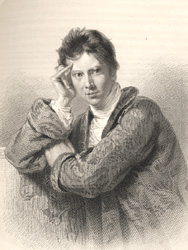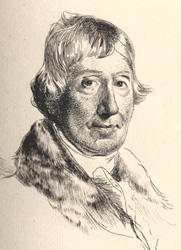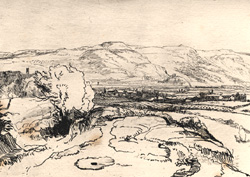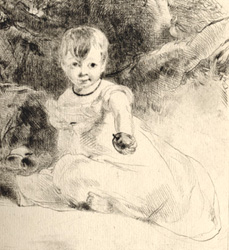|
|
Home | Corson
Collection | Biography | Works | Image
Collection | Recent
Publications | Correspondence | Forthcoming
Events | Links | E-texts |
Contact
Andrew Geddes (1783-1844)
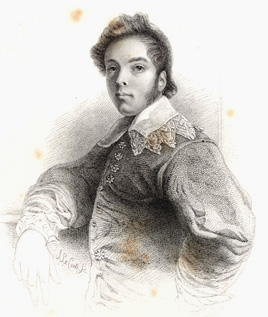 The
painter and etcher Andrew Geddes was born on 5 April 1783 in Edinburgh,
where his father was Deputy-Auditor of Excise and a keen connoisseur
and collector of art. Although Geddes showed early talent for art,
he was placed as a clerk in his father's office after completing
a classical education at the High School and University of Edinburgh.
It was only after his father's death in 1803 that Geddes took the
step of devoting himself entirely to art. In 1806, he travelled
to London to study at the Royal Academy and, in the same year,
exhibited his first painting 'St. John in the Wilderness'. Among
his colleagues at the Academy was his countryman David
Wilkie, who became a close friend and with whom he would be
strongly associated in the public mind. As a mature student, Geddes
felt that he could not afford, financially or professionally, to
complete a full ten-year course of studies at the Academy and in
1810, he returned to Edinburgh and opened a studio in York Place.
He was soon in constant demand as a portrait-painter, portraying,
amongst others, the novelist Henry Mackenzie, the publisher and
bookseller Archibald Constable, the antiquary George Chalmers,
and his fellows artists Wilkie, William Allan, Alexander Nasmyth,
Benjamin Robert Haydon, Archibald Skirving, Anthony Stewart, the
Revd. John Thomson, Andrew Wilson, George Sanders, and Nathaniel
Plimer (his future father-in-law). The
painter and etcher Andrew Geddes was born on 5 April 1783 in Edinburgh,
where his father was Deputy-Auditor of Excise and a keen connoisseur
and collector of art. Although Geddes showed early talent for art,
he was placed as a clerk in his father's office after completing
a classical education at the High School and University of Edinburgh.
It was only after his father's death in 1803 that Geddes took the
step of devoting himself entirely to art. In 1806, he travelled
to London to study at the Royal Academy and, in the same year,
exhibited his first painting 'St. John in the Wilderness'. Among
his colleagues at the Academy was his countryman David
Wilkie, who became a close friend and with whom he would be
strongly associated in the public mind. As a mature student, Geddes
felt that he could not afford, financially or professionally, to
complete a full ten-year course of studies at the Academy and in
1810, he returned to Edinburgh and opened a studio in York Place.
He was soon in constant demand as a portrait-painter, portraying,
amongst others, the novelist Henry Mackenzie, the publisher and
bookseller Archibald Constable, the antiquary George Chalmers,
and his fellows artists Wilkie, William Allan, Alexander Nasmyth,
Benjamin Robert Haydon, Archibald Skirving, Anthony Stewart, the
Revd. John Thomson, Andrew Wilson, George Sanders, and Nathaniel
Plimer (his future father-in-law).
| When travel to the Continent became possible
in 1814, Geddes visited Paris and studied the great works of
Veronese, Titian, Giorgione, Correggio, Jordaens, and Rubens
that Napoleon's armies had looted from conquered territories.
Rubens's The Assumption of the Virgin was the inspiration
for Geddes's only recorded commission as a religious artist,
an Ascension painted in 1815 for the Church of St
James's Garlickhythe in London. In February 1818 Geddes
was among the artists chosen to make a record of the newly
rediscovered Regalia of Scotland. Having completed two drawings
for the official report into the rediscovery, Geddes began
work on a massive group-portrait depicting the moment at which
the
twenty-four Royal Commissioners opened the chest containing
the Regalia. Among his studies for this composition was a portrait of
Scott (1818). The Discovery
of the Regalia of Scotland was finally displayed at
the Royal Academy in 1821 and subsequently formed the centrepiece
of a collected exhibition of his work in Edinburgh in the same
year. The piece, however, found no buyer and subsequently perished
through neglect. |
Click on the thumbnail
to see a full-size engraving of Geddes's portrait
of Wilkie by William Holl the Younger
|
|
Although frustrated in his attempts to secure election to Associate
membership of the Royal Academy, Geddes transferred his studio
to London and continued to attract prestigious commissions throughout
the 1820s, notably a massive portrait of Frederick August, Duke
of York. In 1826, following Wilkie's example, he published a limited
edition of portfolios of etchings. Geddes is now perhaps more highly
regarded as an etcher than as a painter and has been credited with
heralding an etching revival. His collected etchings -- including
portraits such as Mrs Geddes, the Artist's Mother, George
Chalmers, and Sir William Allan, and landscapes like The
Field of Bannockburn and the Bore Stone and Peckham Rye --
were published by the collector David
Laing in 1875.
|
|
Click on the
thumbnails to see full-size etchings of George Chalmers (left)
and The Field of Bannockburn and the Bore Stone (right)
|
|
Following Geddes's marriage to Adela Plimer (his future biographer)
in 1827, he set out for a three-year sojourn in Italy and engaged
in a lengthy study of the artists of the Venetian School. His decision
to return to London in 1831 was partly prompted by the onset of
consumption. On his way home, he made a stay in Munich to study
the Rubens collections. Back in London, he was finally elected
Associate member of the Academy in 1832. Throughout the 1830s,
Geddes continued to exhibit portraits, landscapes, and subject
paintings, the latter increasingly displaying literary and religious
motifs. In 1839, he travelled to Holland to study Rembrandt whom
he particularly admired as an etcher. Geddes suffered a renewed
attack of consumption in spring 1844 but refused all medical assistance
in his effort to complete his submissions to the annual exhibition
of the Royal Academy. These included Geddes's only other Scott-related
project: an imaginary portrait of Jenny Denison, Edith Bellenden's
maidservant in The
Tale of Old Mortality. Geddes died in his wife's arms
on 5 May 1844.
|
|
Click
on the image to see a full-size image of Geddes's
etching Child with an Apple
|
|
Bibliography
- Dictionary of National Biography (London:
Oxford University Press, 1921)
- Etchings by Sir David Wilkie,
Limner to H.M. for Scotland, and by Andrew Geddes: With
Biographical Sketches by David Laing (Edinburgh:
Printed by R. & R. Clark, 1875)
- Geddes, Adela Plimer. Memoir of the Late
Andrew Geddes, Esq., A.R.A. (London: W. Clowe, 1844)
- McEwan, Peter J. M. Dictionary
of Scottish Art & Architecture (Woodbridge, Suffolk:
Antique Collectors' Club, c1994)
- Russell, Francis. Portraits
of Sir Walter Scott: A Study of Romantic Portraiture (London:
The Author, 1987)
- Smailes, Helen. Andrew
Geddes, 1783-1844, Painter-Printmaker: 'A Man of Pure Taste'
(Edinburgh: National Gallery of Scotland, 2001)
Back to Index
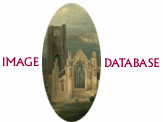
Last updated: 12-Sept-2005
© Edinburgh University Library
|
|

 The
painter and etcher Andrew Geddes was born on 5 April 1783 in Edinburgh,
where his father was Deputy-Auditor of Excise and a keen connoisseur
and collector of art. Although Geddes showed early talent for art,
he was placed as a clerk in his father's office after completing
a classical education at the High School and University of Edinburgh.
It was only after his father's death in 1803 that Geddes took the
step of devoting himself entirely to art. In 1806, he travelled
to London to study at the Royal Academy and, in the same year,
exhibited his first painting 'St. John in the Wilderness'. Among
his colleagues at the Academy was his countryman
The
painter and etcher Andrew Geddes was born on 5 April 1783 in Edinburgh,
where his father was Deputy-Auditor of Excise and a keen connoisseur
and collector of art. Although Geddes showed early talent for art,
he was placed as a clerk in his father's office after completing
a classical education at the High School and University of Edinburgh.
It was only after his father's death in 1803 that Geddes took the
step of devoting himself entirely to art. In 1806, he travelled
to London to study at the Royal Academy and, in the same year,
exhibited his first painting 'St. John in the Wilderness'. Among
his colleagues at the Academy was his countryman 